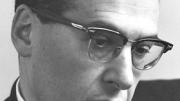In the fall of 1945, at Los Alamos, New Mexico, scientists working on the Manhattan Project heard Julian Schwinger deliver a brilliant lecture about a new accelerator he had designed. Mallinckrodt research professor Roy Glauber, then just 20 years old, his undergraduate studies at Harvard on hold as he helped develop the atom bomb, was in the audience. Glauber’s impression of Schwinger was of a short man with swept up “pompadour hair in front that gained him an inch in height.” The talk itself Glauber found “extraordinary: he had worked out everything” about the device, right “down to a complete theory of the radiative losses.” No other lecture Glauber heard while at Los Alamos had such “smoothness, continuity, or cogency.” Upon his return to Cambridge after the war, he sought out Schwinger at MIT, where the theoretical physicist had been working on the development of radar, and was, again, impressed—and then delighted when Schwinger came to Harvard the following year. (Schwinger, Glauber recalled, was rarely seen at MIT because he worked late at night. “But people would leave him problems—great problems of the day in physics—to solve on the blackboard, and he would sometimes solve them.”)
When former students of Schwinger (Glauber among them) gathered in Jefferson Laboratory to remember their Nobel Prize-winning mentor on Monday, February 12 (100 years to the day after his birth), it was hard to say who was more distinguished: the master or his mentees. Schwinger shared the 1965 Nobel in physics for work in quantum electrodynamics. Four of his students also became Nobel laureates—Glauber, Ben Roy Mottelson, Ph.D. ’50, and Sheldon Glashow in physics, and Walter Kohn in chemistry—as did his onetime assistant, Walter Gilbert, also in chemistry. (Three of the five—Gilbert, Glashow, and Glauber—were present.)
Mallinckrodt professor of physics Howard Georgi moderated, and as the panelists spoke, it was clear that they thought Schwinger was a singularity. Georgi recalled “magnificent lectures” by a professor in “total control of both material and class.” “Only one student ever asked a question,” he added. “Schwinger ignored him.”
Schwinger, himself a shy student, had been discovered by Columbia professor I. I. Rabi, a Nobel laureate who became almost “a godfather, of the good kind,” recalled Glauber. Rabi sent Schwinger to study with J. Robert Oppenheimer ’26, S.D. ’47, which was unusual, Glauber explained, because “Oppenheimer was in a league of his own” and wasn’t known for mentoring students.
Schwinger’s own courses at Harvard did not always follow the normal academic schedule. Glauber recalled one that began in the fall of 1947 and went on for three semesters. “Schwinger started with the one-body problem [determining the motion of a single point particle], then spent two semesters on the two-body problem [determining the motion of two point particles that interact only with each other, such as an electron orbiting an atomic nucleus]…”
Loeb University Professor emeritus Walter Gilbert, who spent a year as Schwinger’s assistant after earning his doctorate at Cambridge University, remembered how “the physics world centered on Julian…” and how in his lectures, he would cover the entire blackboard with equations, “from one corner to another.”
MIT professor of applied mathematics emeritus Daniel Kleitman, who earned his Ph.D. with Schwinger and Glauber in 1958, described what those “brilliant and inspirational” lectures were like:
The class consisted of about 30 students. At exactly five minutes after the hour, Schwinger would arrive at the door, and immediately begin his lecture. He spoke without notes and talked in a quiet voice, in a manner so crystal-clear and persuasive that it was hypnotic. We all listened, wrote notes with complete concentration; nobody dared to ask a question. Aside from his voice and the sound of his chalk, there was absolute silence in the room (aside from occasional burps from a classmate who had a digestive disorder.) At exactly five minutes before the hour, he would position himself close to the door, put down his chalk, and exit, often moving rapidly toward his sports car…. The lectures were as well organized and informative as any I have ever experienced—every one of them.
Sheldon Glashow, Metcalf professor of mathematics and the sciences at Boston University, and Higgins professor of physics emeritus at Harvard, who earned his Ph.D. in 1959, recalled 99-cent lunches in Harvard Square at which Schwinger would regale an entourage of favored students. Glashow, who shared the Nobel Prize in physics in 1979 for contributions to electroweak unification models, credits his mentor with the idea that set him on the path to this discovery: “Schwinger was indeed the first person to invoke Yang-Mills gauge theories, as we call them today, to unify weak and electromagnetic interactions. I found no such allegation anywhere in the literature, aside from in his 1956 paper. So, he sent me off, and said ‘Do it.’”
As the event to honor Schwinger wound down, former student Frederick Cooper, Ph.D. ’69, who works at Los Alamos National Laboratory, spoke from the audience. “The most moving thing that happened was when Schwinger won the Nobel Prize. [The room] was filled with people, and reporters, and Schwinger got up and said: ‘I woke up this morning, and the problems I couldn’t solve yesterday, I can’t solve today.’ And then he went on and gave his usual lecture. I thought that was extraordinary, apart from everything else that he did that was extraordinary: that humility. What does it mean to have a prize, for a brilliant mind like his?”











